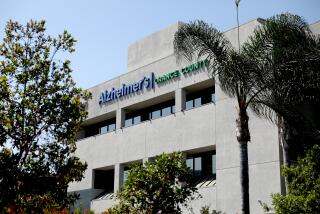Possible Relief for Macular Degeneration Patients
- Share via
Macular degeneration, a leading cause of blindness in the elderly, appears to be yielding to new laser treatments that seal off destructive blood vessels behind the retina.
Although doctors caution that the treatments do not offer a cure, they say the therapies have in many cases arrested the downward course of a disease that ordinarily robs people of their sight.
Next month, the U.S. Food and Drug Administration is expected to approve a drug, verteporfin, that is used in concert with a low-powered laser. FDA approval would extend this therapy well beyond the 600 or so patients who have received the treatment in an international clinical trial.
The trial, directed by the Johns Hopkins Wilmer Eye Institute, found that “photodynamic therapy” helped the majority of patients who meet a certain case definition--a predominance of fast-growing rather than less aggressive blood vessels. When it worked, the treatment kept the condition from getting worse. Some patients even saw their vision improve.
Dr. Neil Bressler, the Hopkins ophthalmologist who headed the study, said about 30% of the 200,000 Americans diagnosed each year with “wet” macular degeneration are candidates for the treatment. But patients must be treated early in the disease while they have significant vision to save.
“We can’t treat everybody,” Bressler said. “But for the person who otherwise would have lost a lot of vision and now has some sight preserved, the treatment is very significant.”
In a simple office visit, patients receive an intravenous infusion of the drug, which seeks out the abnormal blood vessels. Minutes later, the doctor targets the vessels with a low-powered laser that “turns on” the drug, setting in motion a chemical reaction that seals off the vessels and causes them to dry up.
For more than a decade, doctors have used lasers more crudely to destroy bleeding vessels. The laser not only burned off the destructive vessels, but also a band of retinal cells in its path. In the best cases, the treatment kept the disease from progressing but left vision more impaired than before.
“Wet” macular degeneration occurs when tiny capillaries grow behind the macula, a small portion of the retina responsible for central vision. The vessels can bleed and scar, destroying light-sensing nerve cells and opening an ever-widening hole in a person’s sight.
The disease can take years to progress but often moves with lightning speed. Some patients notice a wavy line one day, a huge blur weeks later.
The “wet” disease, which gets its name from the bleeding capillaries, is less common than the “dry” form but more apt to cause blindness. The “dry” disease, which progresses more slowly, is marked by the deterioration of cells responsible for central vision.
As the FDA reviews photodynamic therapy, doctors are reporting exciting progress with other treatments. In Towson, Md., Dr. Bert Glaser said he has achieved positive results in two-thirds of the patients who received a laser treatment called “feeder vessel” therapy.
In this treatment, which does not involve a medication, Glaser shines a laser on tiny vessels--often just a millimeter long--that provide blood to the capillaries destroying sight. He likens this to sealing the stem that supplies the veins of a leaf. Many patients have only one feeder vessel, he said.
Although he has reported results of about 30 patients, a relatively small study group, Glaser said he has achieved similar results in a larger group of patients but is still analyzing the data. Doctors in Italy and Japan have also reported about the same rate of success in small studies, he said.
With therapies progressing at a rapid pace, some doctors say people older than 55 should check their vision daily for subtle changes that might signal the early onset of macular degeneration.
“Cover each eye, and look at the edges where the ceiling meets the wall,” said Glaser, who urges patients to see an eye doctor if any of the lines appear wavy. “There should be a campaign in America like self-examination for breast cancer.”
Doctors are hopeful that the treatments will benefit patients over the long term but caution that several questions remain unanswered.
“All these treatments are exciting, but we’re approaching them with a certain level of skepticism, said Dr. Scott Steidl, a retinal specialist at the University of Maryland Medical Center.
He said feeder vessel therapy was “fantastic . . . very clever” but that it is unclear whether doctors using sophisticated imaging equipment can find all the feeder vessels they need to target. And he said patients receiving photodynamic therapy appear to grow new vessels after being treated, though the new vessels appear to be less harmful.
Patients, he said, are eager to try any therapy that offers hope.
“This disease hits people in the prime of their life, often after they’ve made their mark on society and are ready to retire and enjoy the fruits of their labor,” Steidl said. “The frustrated interactions I’ve had with people almost can’t be described.”





